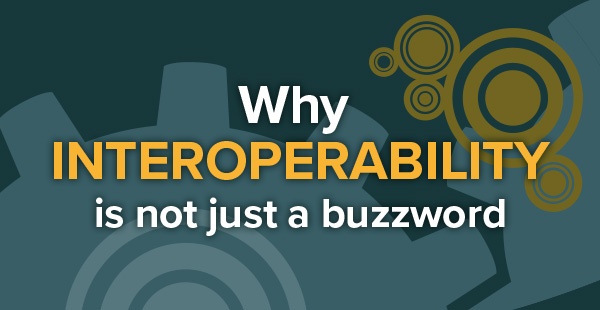Why “Interoperability” Is Not Just a Buzzword
by Core Solutions on October 3, 2016

Among the hottest topics in healthcare and technology today is the concept of interoperability – and we are ready to boldly make the case that it is not just a buzzword, but rather a progressive movement in healthcare information technology (HIT) worldwide. The essence of interoperability set forth in layman’s terms by Scott Wallace, JD, MBA, is simply, “personal health information, entered into a system once, becomes available to patients wherever they are and whenever they need it.” Today, the mandate for electronic health records (EHRs) is the driving force behind this concept, helping to advance population health and information management to achieve improved outcomes across the healthcare ecosystem.
On April 5, 2013, the HIMSS Board approved the following definition of interoperability: In healthcare, interoperability is the ability of different information technology systems and software applications to communicate, exchange data, and use the information that has been exchanged. Data exchange schema and standards should permit data to be shared across clinicians, lab, hospital, pharmacy, and patient regardless of the application or application vendor. Interoperability means the ability of health information systems to work together within and across organizational boundaries in order to advance the effective delivery of healthcare for individuals and communities.
The description includes three definitive levels of HIT interoperability, including:
- Foundational
Foundational interoperability allows data exchange from one information technology system to be received by another and does not require the ability for the receiving information technology system to interpret the data. One can think of foundational interoperability as serving as the base of a communications pyramid, offering the most basic of data exchange services.
- Structural
Structural interoperability is an intermediate level that defines the structure or format of data exchange where there is uniform movement of healthcare data from one system to another such that the clinical or operational purpose and meaning of the data is preserved and unaltered. Structural interoperability defines the syntax of the data exchange, ensuring that data exchanges between information technology systems can be interpreted at the data field level.
- Semantic
Semantic interoperability provides interoperability at the highest level, which is the ability of two or more systems or elements to exchange information and to use the information that has been exchanged. Semantic interoperability takes advantage of both the structuring of the data exchange and the codification of the data including vocabulary so that the receiving information technology systems can interpret the data. This level supports the electronic exchange of patient summary information among caregivers and other authorized parties via potentially disparate EHR systems and other systems to improve quality, safety, efficiency, and efficacy of healthcare delivery.
According to the latest data brief from the Office of the National Coordinator for Health IT in 2015, 52 percent of hospitals can electronically find patient health information, 85 percent can send patient summary of care records, 65 percent can receive such records and 38 percent can use or integrate those records into their own EHRs without manual entry. Additionally, more than a quarter conduct all four of these key domains of interoperability, up from 23 percent, in 2014. As additional government mandates and successful patient and clinician outcomes emerge, interoperability will continue to infiltrate the healthcare ecosystem, shifting from its state as a buzzword to an industry fundamental.
For more information on interoperability, take a look at the sources below:
- The State of Interoperability: 5 Statistics from the ONC, Becker’s Hospital Review
- What is Interoperability?, HIMSS
- What is EHR Interoperability and why is it important?, HealthIT.Gov
- Connecting Health and Care for the Nation, the ONC for Health Information Technology
- Understand the Three Levels of Interoperability, Health Language
- April 2024 (2)
- March 2024 (4)
- February 2024 (1)
- October 2023 (3)
- September 2023 (3)
- August 2023 (2)
- June 2023 (2)
- May 2023 (3)
- April 2023 (4)
- March 2023 (2)
- November 2022 (3)
- October 2022 (1)
- September 2022 (1)
- August 2022 (3)
- July 2022 (1)
- June 2022 (1)
- January 2022 (2)
- December 2021 (1)
- October 2021 (2)
- September 2021 (2)
- August 2021 (2)
- July 2021 (5)
- June 2021 (5)
- March 2021 (2)
- January 2020 (3)
- November 2019 (3)
- October 2019 (2)
- July 2019 (1)
- June 2019 (1)
- May 2019 (1)
- April 2019 (3)
- October 2018 (1)
- September 2018 (1)
- August 2018 (1)
- July 2018 (1)
- June 2018 (1)
- May 2018 (2)
- April 2018 (1)
- March 2018 (1)
- December 2017 (1)
- October 2017 (2)
- September 2017 (1)
- June 2017 (2)
- May 2017 (2)
- April 2017 (1)
- February 2017 (2)
- January 2017 (3)
- November 2016 (2)
- October 2016 (3)
- September 2016 (2)
- August 2016 (1)
- July 2016 (2)
- June 2016 (1)
- May 2016 (3)
- April 2016 (2)
- March 2016 (2)
- February 2016 (2)
- January 2016 (3)
- December 2015 (2)
- November 2015 (4)
- October 2015 (3)
- September 2015 (4)
- August 2015 (1)


Let us know what you think